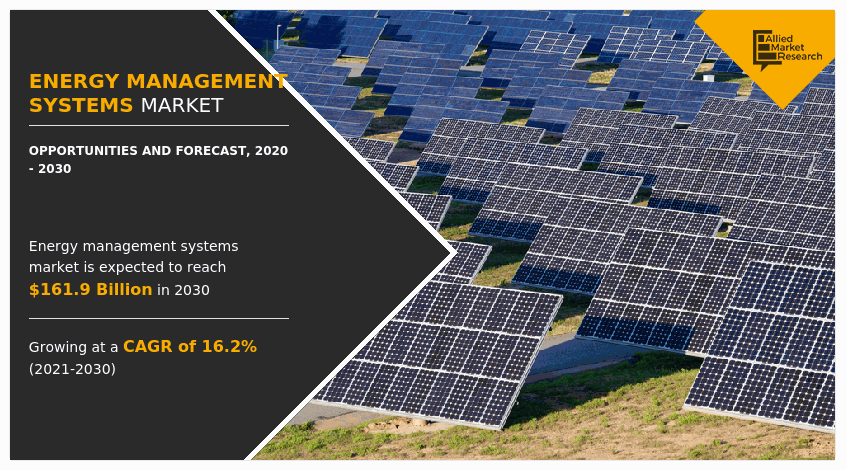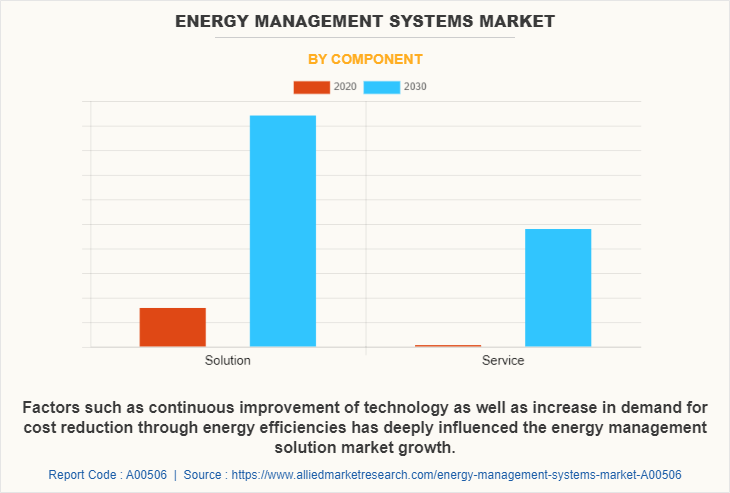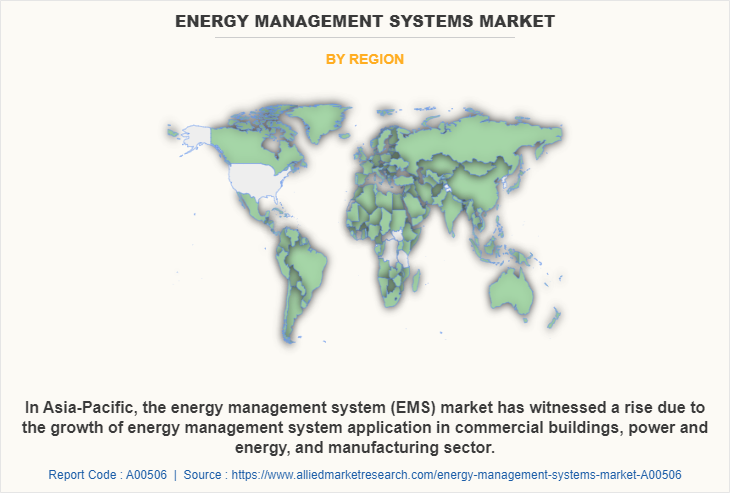Energy Management Systems Market Insights, 2030
The global energy management systems market size was valued at USD 36.2 billion in 2020, and is projected to reach USD 161.9 billion by 2030, growing at a CAGR of 16.2% from 2021 to 2030.
An energy management system (EMS) is a system of computer-aided tools used by operators of electric utility grids to monitor, control, and optimize the performance of the generation or transmission system. It can be used in small scale systems such as microgrids. It is one of the emerging technologies that enable an organization to collect real-time information on the energy use through monitoring, assessing, and visualizing energy consumption. This concept not only monitors energy consumption however also helps make data driven decisions and enhance enterprise-level operation & financial decisions.

Energy management solutions have gained popularity since they help gain competitive advantage, increase productivity, and reduce energy cost. In addition, the government policies toward energy conservation & the limited availability of fossils is drawing attention of the corporate. Every industry small or big is running with the help of energy, so it is essential to deploy energy management system. Although technology is advancing at a brisk pace, the end-use clients may not be adopting the same as quickly. Most of the potential buyers of energy management systems are at a stage where they are aware about the benefits of implementing such system, however preferably utilizing traditional technology and applications which impedes energy management systems industry. Financial barriers, limited expertise, and fragmented stakeholders are some of the key challenges for the energy management systems market.
Conversely, the energy management systems market is expected to offer several opportunities for new players in the market. Rise in the demand for energy management systems across industrial, commercial, and residential sectors is driven by their ability to improve energy efficiency. By analyzing consumption patterns, EMS can optimize energy usage, minimize waste, and help organizations reduce costs while meeting their sustainability goals. In addition, the increase in the integration of Internet of Things (IoT) devices and Artificial Intelligence (AI) enables improved predictive analytics, demand-response solutions, and automated energy optimization, enhancing efficiency and reducing costs. This innovative approach offers substantial growth potential, as it enables smarter, more responsive energy management across various sectors.
For instance, on July 17, 2024, OBM, Inc. launched a first-to-market solution to address the energy demands of artificial intelligence (AI) computing. This new product, an extension of their Foreman platform, offers pause-less energy curtailment, allowing AI compute to continue without interruptions during grid balancing events. This innovation aims to reduce the significant energy consumption of AI models, providing a critical solution for the industry.
Furthermore, building energy management systems are gaining traction with the rise of smart buildings and the focus on energy-efficient construction. These systems optimize the management of HVAC, lighting, and other energy-consuming components, enhancing overall energy efficiency, essential in sustainable building practices and cost-effective facility management. These factors are expected to provide remunerative energy management systems market opportunities for the growth of the market.
For instance, on September 9, 2024, TeraHive launched three intelligent energy management solutions: the TeraHive Energy Suite, Charging Station Management Solution, and Enterprise Energy Management. These solutions aim to optimize energy storage, usage, efficiency, and performance. The TeraHive Energy Suite is a modular and scalable residential energy management and battery system, while the Charging Station Management Solution supports EV charging infrastructure. The Enterprise Energy Management solution is designed for commercial applications, providing data collection, analytics, and intelligent forecasting.
Furthermore, the surge in the energy independence and localized solutions has spurred the growth of microgrid technology. Energy management systems are essential in managing microgrids, monitoring and optimizing performance, and ensuring efficient energy distribution and fault tolerance, providing reliable and resilient energy management. In addition, the rise in the demand for advanced data analytics offers valuable insights into energy consumption patterns, enabling businesses to optimize their energy use. Energy Management Systems (EMS) that incorporate predictive maintenance, performance optimization, and real-time data monitoring can significantly reduce energy costs and operational inefficiencies. These factors are expected to offer lucrative energy management systems market opportunities for growth.
For instance, on June 04, 2024, ABB launched the ReliaHome™ Smart Panel energy management solution in the U.S. and Canada. This innovative solution provides on- and off-grid energy optimization and insights, allowing homeowners to better control their electricity use and save on energy costs through a user-friendly app1. The ReliaHome Smart Panel is compatible with third-party devices such as batteries, solar inverters, electric vehicle chargers, and standby generators, making it suitable for both new and retrofit installations.
Market Trends Insights:
The energy management systems market size is expected to witness several noteworthy trends in the market. One of the significant trends is the rise in integration energy management systems with smart offering significant market potential. Smart grids enhance electricity distribution and improve grid resilience, making them crucial for modern energy infrastructure, driving efficiency and sustainability in energy management. In addition, the increase in the integration of renewable energy sources has led to the surge in the high demand for energy management systems that helps to optimize the use of solar, wind, and other renewable sources. These EMS solutions are essential for managing the intermittency and variability of renewable energy, ensuring a smoother and more efficient integration with the grid. Furthermore, there is a growing demand for energy management systems that enable organizations to monitor, report, and reduce carbon footprints. This trend presents a significant opportunity for software providers to develop solutions that help businesses comply with these new regulations, driving both environmental sustainability and regulatory adherence.
For instance, August 10, 2024, ABB partnered with Samsung Electronics to enhance user experience in energy management. This collaboration aims to integrate ABB's InSite energy management system with Samsung's SmartThings and SmartThings Pro platforms. The goal is to provide a more seamless and efficient way to manage energy consumption in both residential and commercial buildings. This partnership aimed to help users monitor and control various devices and systems, such as HVAC, lighting, and security, through a single application. By optimizing energy usage, it can lead to significant cost savings and a reduction in carbon emissions.
Another notable trend in the market is the upsurge in the use of renewable energy, energy storage systems that help to manage and optimize, balancing supply and demand, especially with intermittent renewable sources. This integration ensures a more stable and efficient energy supply, highlighting the importance of advanced EMS solutions in the renewable energy landscape. In addition, the shift in preference toward demand-response programs allow companies to adjust their energy consumption based on grid demand, helping to reduce peak demand and prevent power shortages. Energy management systems automate energy load adjustments, enhancing grid stability and providing significant cost savings and operational benefits for utilities and participating companies. Furthermore, there is a growing trend toward the interconnectivity of energy systems, which has led to the rise in the demand for robust cybersecurity solutions. EMS providers that integrate secure protocols to protect against cyber threats can capitalize on market opportunities. Securing energy systems is vital for maintaining operational integrity and safeguarding critical infrastructure.
For instance, on August 6, 2024, gridX partnered with greenblocks to revolutionize energy management for households in the Rhine-Main region. This collaboration aimed to provide a comprehensive energy solution by integrating distributed energy resources (DERs) such as photovoltaic systems, battery storage, heat pumps, and wallboxes with energy-efficient refurbishments. The core of their offering is the "liya" energy manager, which connects all locally-installed DERs, allowing customers to maximize the usage of their own solar energy and optimize all energy flows from generation to consumption. This partnership is expected to significantly improve energy efficiency and reduce energy costs for households in the region.
Segment Review:
The global energy management systems market is segmented on the basis of component, end user, type, application, and region. The component segment is bifurcated into solution and service. By end user, the market is segmented into energy and utilities, IT and telecom, manufacturing, retail, healthcare, and others. Furthermore, on the basis of type, the market is categorized into home energy management systems, building energy management systems, and industrial energy management systems. By application, the market is broadly classified into residential and commercial. In addition, to gain further diverse insight, the market is analyzed across major regions, namely, North America, Europe, Asia-Pacific, and LAMEA.

Depending on component, the solution segment holds the largest energy management systems market size as the solutions allow for real-time gathering of key data and energy readings which further enables effective management of energy resources. In addition, increase in interest in EMS across different industry verticals as well as technological advancements, availability of cheap labour, and low manufacturing cost are some of the major factors that drive the energy management systems market growth. However, service segment is expected to witness growth at the highest rate during the forecast period, as large organizations are opting for third party energy management solutions to better optimize their energy resources.
Report Coverage & Deliverables:
The energy management systems (EMS) market report provides a comprehensive analysis of the sector, including global and regional market size estimates, growth projections, and key industry trends. It delves into the primary drivers, challenges, and opportunities influencing the EMS market, with a particular focus on the impact of energy efficiency regulations, sustainability goals, and the integration of renewable energy sources. The report further examines shifting consumer preferences toward smarter, more efficient energy solutions and how these factors are shaping market dynamics.
Key deliverables include detailed market forecasts, alongside an in-depth exploration of competitive strategies adopted by key market players. The report also provides valuable insights into the technological advancements within the EMS industry, particularly the role of IoT, AI, and big data analytics in optimizing energy consumption and operational efficiency.
Competitive Analysis:
The key players that operate in the energy management systems market are C3, Inc., Delta electronics, Inc., Dexma, General Electric company, Gridpoint, Honeywell international Inc., Johnson controls international plc, Schneider Electric S.E, Siemens and Yokogawa electric corporation. These key players have adopted various strategies, such as product portfolio expansion, mergers & acquisitions, agreements, geographical expansion, and collaborations, to increase their market penetration and strengthen their foothold in the energy management systems industry.
Recent Product Launches in the Industry:
In July 2024, Schneider Electric launched an AI-powered home energy management feature for its Wiser Home app. This new feature optimizes energy management for two of the biggest power loads in the home water heaters and electric vehicle chargers. By using predictive algorithms, it learns from user habits, real-time weather forecasts, tariff data, and solar production capabilities to optimize energy savings. This innovation aims to help homeowners reduce their energy bills and manage their energy consumption more efficiently.
Recent Partnerships in the Industry:
- In January 2025, Naarea, partnered with QGEMS to integrate QGEMS' technology to optimize Naarea's energy production and distribution. The partnership is set to commence in 2025 and will initially target the UK and US markets. By leveraging QGEMS' platform, Naarea plans to enhance the efficiency and reliability of its energy operations, ensuring seamless integration into the broader energy grid and various sectors.
- In March 2025, Panasonic partnered with tado°, an IoT-based home energy management platform provider. This partnership aims to integrate tado°'s Smart Thermostats and Heat Pump Optimizer with Panasonic's Aquarea Heat Pumps, enhancing energy efficiency and reducing energy consumption by up to 20%1. The collaboration leveraged advanced technologies to optimize heating performance and reduce CO2 emissions.
- In November 2024, REPLUS Engitech partnered with Green Power Monitor (GPM) to promote AI-driven energy management systems and power plant controllers in India and beyond1. This collaboration aims to enhance grid stability, integrate renewable energy sources, and advance large-scale battery energy storage systems (BESS). By leveraging GPM's advanced technology, including their Power Plant Controller and Energy Management System, the partnership seeks to optimize energy flows and improve the efficiency of various energy platforms such as solar, wind, and hybrid plants.
- In December 2024, Tata Consultancy Services (TCS) partnered with Landis+Gyr to deliver next-generation energy efficiency solutions for utilities. This collaboration aimed to integrate TCS's Clever Energy platform with Landis+Gyr's advanced smart metering and grid management technologies1. The goal is to help utilities optimize energy usage, improve operational efficiency, and reduce carbon emissions.
Regional Review:

Region wise, the energy management systems market share was dominated by Asia-Pacific in 2020 and is anticipated to grow at a significant rate during the forecast period, due to the rise in digitization and increase in data generated by IoT devices. Moreover, with the growing energy needs and high carbon footprint of the region, many organizations are leaning towards energy management systems are to optimize the energy resources for their operations.
Type Insights:
The report explores the E energy management systems market, focusing on the different types of energy management solutions available, including hardware, software, and services. EMS are designed to monitor, control, and optimize energy consumption across various industries, helping organizations reduce costs and improve energy efficiency. The report outlines the key features and benefits of these systems, such as real-time energy monitoring, data analytics, and predictive maintenance capabilities.
The market for EMS is rapidly growing, driven by increasing energy costs, sustainability initiatives, and the need for regulatory compliance. Key differences between EMS types are highlighted, such as the distinction between enterprise-level systems and more localized, sector-specific solutions. The report also emphasizes the importance of integrating EMS with smart grids, renewable energy sources, and IoT technologies for enhanced performance.
By providing a detailed analysis of the EMS market, the report offers valuable insights into the evolving landscape of energy management. It highlights the role of EMS in reducing carbon footprints and achieving energy efficiency goals, making them an essential tool for both commercial and industrial applications. This comprehensive understanding of the EMS market helps stakeholders make informed decisions and capitalize on emerging opportunities.
Top Impacting Factors:
Rise in inclination toward energy efficiencies
Energy is the primary source of social and economic progress. Every sector needs energy to operate and due to highly competitive market and technological improvements, there is a constant demand for energy. The industrial sector, in particular, requires a lot of power. There is also a growing awareness of the need to optimize energy use and save it. Furthermore, due to market pressure and public awareness of environmental sustainability, enterprises have attempted to use energy more effectively. The desire to reduce and optimize energy use is projected to be a major market driver.
Energy price volatility
Energy prices fluctuate owing to of changes in supply and demand. Energy prices are influenced by a variety of factors, including extreme weather, economic conditions, and supply availability. According to the World Energy Outlook, energy consumption is expected to rise by 60% in the next 25 years, with developing countries accounting for the majority of this increase. Fossil fuels such as coal and thermal power plants currently provide a substantial quantity of energy in emerging countries. This is the most affordable non-renewable kind of generating energy. Increased energy demand and the depletion of natural resources are predicted to push other, more expensive forms of energy generation forward, resulting in higher energy prices. There has been a huge drop in the amount of energy used across the board. A significant reduction in energy consumption across several markets is anticipated to decrease the energy prices, particularly relative to the impact of the increased energy demand. Hence, factors such as constrained energy supply and increased energy cost due to volatility in energy prices are expected to fuel the energy management systems market demand.
Key Benefits For Stakeholders:
- This report provides a quantitative analysis of the energy management systems market forecast, current trends, estimations, and dynamics of the energy management systems market analysis from 2020 to 2030 to identify the prevailing energy management systems market opportunities.
- The energy management systems market research is offered along with information related to key drivers, restraints, and opportunities.
- Porter's five forces analysis highlights the potency of buyers and suppliers to enable stakeholders make profit-oriented business decisions and strengthen their supplier-buyer network.
- In-depth analysis of the energy management systems market segmentation assists to determine the prevailing energy management systems market opportunities.
- Major countries in each region are mapped according to their revenue contribution to the global energy management systems market.
- Market player positioning facilitates benchmarking and provides a clear understanding of the present position of the market players.
- The report includes the analysis of the regional as well as global energy management systems market trends, key players, market segments, application areas, and market growth strategies.
Energy Management Systems Market Report Highlights
| Aspects | Details |
| By Component |
|
| By End User |
|
| By Type |
|
| By Application |
|
| By Region |
|
| Key Market Players | Siemens AG, C3 energy, Delta electronics, Johnson controls international plc, Gridpoint Systems, Honeywell International Inc., Schneider Electric, General electric company, yokogawa electric corporation, Dexma |
Analyst Review
An energy management system (or EnMS) is a framework that allows users of energy, such as industrial, commercial, and public sector organizations, to control their energy consumption more efficiently. An effective energy management system can assist businesses in recognizing new opportunities that can adapt and enhance their energy-saving technology, including those that may not demand a large financial and workforce expenditure. Furthermore, the rise in need for sustainable and clean energy management solutions provides great opportunities for the growth of the energy management system market in the coming years.
Key providers of the energy management systems market such as Siemens, General Electric, and Johnson Controls account for a significant share in the market. With growth in requirement for energy management systems, various companies have established partnerships to increase their energy management capabilities. For instance, in November 2021, Siemens announced collaboration with a German multinational science and technology company, Merck to boost machine-to-machine trust in industrial value chains. This collaboration aims to provide instant access to quality and safety information with a single source of truth to enable disruptive business model.
In addition, with surge in demand for energy management systems, various companies have expanded their current product portfolio with increased diversification among customers. For instance, in October 2020, a Japanese multinational electrical engineering and software company, Yokogawa Electric Corporation announced the launch of a cloud-based solution that provides centralized energy and environment management for the enterprise segment. The development of this solution was made possible by the signing of a global partnership agreement with Green Koncepts, a Singapore-based IoT energy management solutions provider.
Moreover, market players have expanded their business operations and customers by increasing their acquisitions. For instance, in April 2021, Johnson Controls announced the acquisition of Silent-Aire, a modular data center company. The acquisition helps to establish Johnson Controls as a global leader in the high-growth data center vertical, with the help of Silent-Aire’s industry-leading cooling equipment technology and modular data center solutions.
The global energy management systems market size was valued at USD 36.2 billion in 2020, and is projected to reach USD 161.9 billion by 2030
The global energy management systems market is projected to grow at a compound annual growth rate of 16.2% from 2020-2030 to reach USD 161.9 billion by 2030
The key players that operate in the energy management system market are C3, Inc., Delta electronics, Inc., Dexma, General Electric company, Gridpoint, Honeywell international Inc., Johnson controls international plc, Schneider Electric S.E, Siemens and Yokogawa electric corporation.
Region wise, the energy management systems market share was dominated by Asia-Pacific in 2020 and is anticipated to grow at a significant rate during the forecast period
Major market driving factors such as Rise in inclination toward energy efficiencies & Energy price volatility
Loading Table Of Content...


